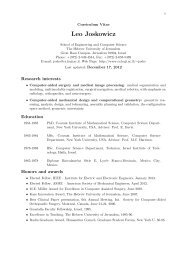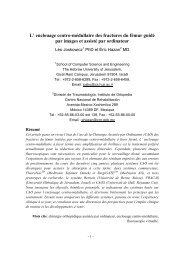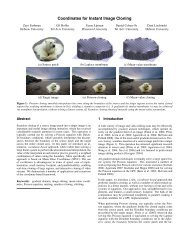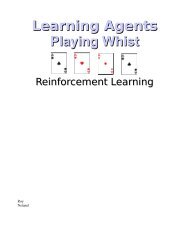TEL AVIV UNIVERSITY Gaddi Blumrosen
TEL AVIV UNIVERSITY Gaddi Blumrosen
TEL AVIV UNIVERSITY Gaddi Blumrosen
You also want an ePaper? Increase the reach of your titles
YUMPU automatically turns print PDFs into web optimized ePapers that Google loves.
1<br />
where Uˆ U , Vˆ V <br />
tr(<br />
)<br />
Later we will see that SVD enables, with appropriate pre and post coding, the transmit<br />
and receive antennas to use independent data streams, called sub-channels.<br />
Rice distribution<br />
A common general MIMO channel distribution is Rice distribution which consists of<br />
weighted summation of a Rayleigh distributed channel, and LOS channel, H ,<br />
based on physical wave superposition:<br />
H aHbH 2 2<br />
Where a, and b are constants normalized to one, a b 1<br />
.<br />
It is common to describe HRician<br />
also as:<br />
H Rician <br />
K<br />
H LOS<br />
K 1<br />
<br />
1<br />
H Ray<br />
K 1<br />
a<br />
where K, the Rician constant (Cofactor), equals to, K <br />
b<br />
Channel matrix rank<br />
1/ 2 1/ 2<br />
R T<br />
T<br />
Rician LOS Ray<br />
(2.25)<br />
(2.26)<br />
Let us denote by r, the rank of channel matrix H. If we define, as above, G to be<br />
consisted of independent Gaussian variables, covariance of G is full rank (though the<br />
H<br />
instantaneous value of GG is not necessarily full rank, due to fading effect), and<br />
thus the channel rank is explicitly determined by the minimum rank of RT and RR<br />
.<br />
Consequently, channel rank is determined by the matrix correlation at receive and<br />
transmit ends and thus determines spatial selectivity.<br />
A more realistic approach, in which G is not assumed to be full is analyzed at [5]. In<br />
this approach wide scale reflectors causes keyhole effect for instance, and reduce the<br />
channel rank. Still, different physical scenarios can lead to same channel<br />
characteristics, so the above assumption is justified for analysis purpose.<br />
2.3.5 Channel feedback quality<br />
H Ray<br />
LOS<br />
Channel Side Information (CSI), is based on the channel estimates, the instantaneous<br />
approximated channel value, h and on channel statistics, the estimated channel mean<br />
value, , and the estimated channel covariance matrix, , and some times on<br />
ˆ<br />
R<br />
m<br />
h/ hˆ<br />
hh/ hˆ<br />
higher statistical moments.<br />
A Lot of research was being held recently in the subject of channel feedback quality.<br />
One of the most extensive works, which studied and tested the effects of noisy side<br />
information and quantized side information on the expected SNR and mutual<br />
information, was held by Narula in [8].<br />
2<br />
2








